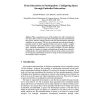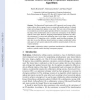1011 search results - page 103 / 203 » The Object Group Design Pattern |
HUC
2005
Springer
14 years 3 months ago
2005
Springer
When computation moves off the desktop, how will it transform the new spaces that it comes to occupy? How will people encounter and understand these spaces, and how will they inter...
IFM
2010
Springer
13 years 8 months ago
2010
Springer
Abstract. The Operational Transformation (OT) approach, used in many collaborative editors, allows a group of users to concurrently update replicas of a shared object and exchange ...
BCB
2010
13 years 5 months ago
2010
Biclustering is a very popular method to identify hidden co-regulation patterns among genes. There are numerous biclustering algorithms designed to undertake this challenging task...
CANDC
2009
ACM
14 years 4 months ago
2009
ACM
Creativity is an important ingredient in problem solving, and problem solving is an important activity for both individuals and societies. This paper discusses our novel approach ...
ICCS
2007
Springer
14 years 4 months ago
2007
Springer
Abstract. Frames, i.e., recursive attribute-value structures, are a general format for the decomposition of lexical concepts. Attributes assign unique values to objects and thus de...


